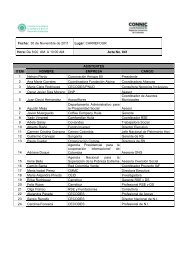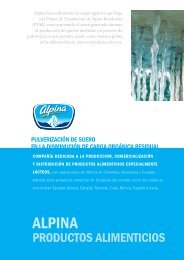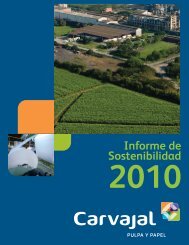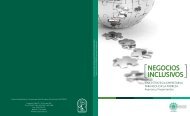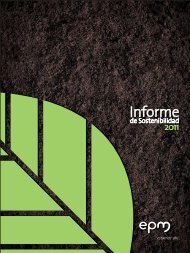Setting new standards - Friends Life
Setting new standards - Friends Life
Setting new standards - Friends Life
You also want an ePaper? Increase the reach of your titles
YUMPU automatically turns print PDFs into web optimized ePapers that Google loves.
FINANCIAL STATEMENTS<br />
IFRS FINANCIAL STATEMENTS<br />
EEV SUPPLEMENTARY INFORMATION<br />
Notes to the consolidated accounts continued<br />
28. Realistic balance sheet continued<br />
Options and guarantees are features of life assurance and pensions<br />
contracts that confer potentially valuable benefits to policyholders.<br />
They are not unique to with-profits funds and can arise in nonparticipating<br />
funds. They can expose an insurance company to two<br />
types of risk: insurance (such as mortality/morbidity) and financial<br />
(such as market prices/interest rates). The value of an option or<br />
guarantee comprises two elements: the intrinsic value and the time<br />
value. The intrinsic value is the amount that would be payable if the<br />
option or guarantee was exercised immediately. The time value is<br />
the additional value that reflects the possibility of the intrinsic value<br />
increasing in future, before the expiry of the option or guarantee.<br />
Under FSA rules all options and guarantees must be valued and<br />
included in policyholder liabilities. For funds within the FSA’s realistic<br />
capital methodology, options and guarantees are valued on a marketconsistent<br />
stochastic basis that takes into account both the time<br />
value and the intrinsic value of the options and guarantees.<br />
The majority of the Group’s life and pensions options and guarantees<br />
are within FPLP’s With-Profits Fund. These are valued stochastically<br />
and included in the realistic liabilities. There are two main types of<br />
guarantees and options in the FPLP With-Profits Fund: maturity<br />
guarantees and guaranteed annuity options. Maturity guarantees are<br />
in respect of conventional with-profits business and unitised withprofits<br />
business and represent the sum assured and reversionary<br />
bonuses declared to date. The cost of these guarantees, net of<br />
charges, has been calculated at £101m (2005: £149m). For certain<br />
with-profits pension policies issued, there are options guaranteeing<br />
the rates at which annuities can be purchased. The cost of these<br />
guarantees has been calculated at £747m (2005: £796m).<br />
The cost of the with-profits guarantees is assessed using a marketconsistent<br />
stochastic model (using The Smith Plus Model as the<br />
scenario generator) and is calculated using 5,000 simulations. The<br />
model has been calibrated using the gilt risk-free curve assuming<br />
interest rates of between 3.9% and 5.3% pa (2005: between 4.0%<br />
and 4.2% pa) and implied volatilities in the market. The capital return<br />
has been calibrated and compared to the actual asset portfolio. For<br />
equities, the capital return volatility varies by year with 20% pa<br />
(2005: 21% pa) assumed in year 7, increasing to 23% pa (2005:<br />
24% pa) by year 14 and 25% pa (2005: 26% pa) by year 21.<br />
Volatility for property returns has been assumed at 15% pa<br />
throughout (2005: 15% pa).<br />
The cost of guarantees also depends on management actions that<br />
would be taken under various scenarios. For example, the future<br />
level of the equity-backing ratio (the ratio of funds held in equities<br />
and property to total investments) varies in each scenario depending<br />
on the ratio of the guarantee cost to the asset share. Similarly,<br />
the reversionary bonus rate is set each year such that, by maturity,<br />
guaranteed benefits are targeted as a prescribed fraction of the total<br />
asset share, leaving the remaining portion of the asset share to be<br />
paid as terminal bonus. The management actions are in line with the<br />
company’s PPFM and are programmed into the model.<br />
The guarantee cost in respect of guaranteed annuity options is<br />
assessed using a market-consistent stochastic model and values<br />
both the current level of the guaranteed annuity rate benefit<br />
(allowing for future improvements in annuitant mortality) and the<br />
time value due to uncertainty in future interest rates.<br />
The guarantee cost in each scenario is the value of the excess<br />
annuity benefit provided by the options, relative to an annuity<br />
purchased in the open market. In estimating the future open market<br />
annuity rate, the model allows for stochastic variation in interest<br />
rates and for future mortality improvements. The stochastic interest<br />
rate assumption reflects that implied by current market interest rate<br />
derivative prices. Future annuitant mortality has been derived from<br />
the premium basis at which annuities can be purchased from<br />
<strong>Friends</strong> Provident Pensions Limited, which allows for future<br />
mortality improvements. Future improvements are difficult to assess<br />
as there is no industry consensus.<br />
The guaranteed annuity options cost also depends upon other<br />
factors such as policy discontinuance and tax-free cash take-up. The<br />
factors are based on recent experience adjusted to reflect industry<br />
benchmarks and to anticipate trends in policyholder behaviour.<br />
A summary of the key assumptions is as follows:<br />
Policy discontinuances: lapse, early retirement and paid-up rates vary<br />
by policy type and period and have been based on recent experience.<br />
Policy lapses for pensions are generally in the range of 1% to 3% pa<br />
(2005: 0.5% to 2% pa) with policy lapses for life business in the<br />
range of 3% to 9% pa (13% pa for mortgage endowment and withprofit<br />
bond policies) (2005: 3% to 9% pa (13% pa for mortgage<br />
endowment policies)). Paid-up rates for pensions are generally in the<br />
range of 7% to 11% pa (2005: 7.5% to 10% pa) with life policies<br />
generally in the region of 0.5% to 2% pa (2005: 1% pa). Early<br />
retirement rates vary by age band and policy type and have been<br />
reviewed and amended in 2006 based on recent experience.<br />
Tax-free cash option: where a guaranteed annuity option is more<br />
valuable than the cash equivalent it is assumed that 18% to 27%<br />
of the benefit is taken as tax-free, depending on type of business<br />
(2005: 18% to 25%). This is based on recent experience.<br />
There are also guarantees and options in respect of some of the<br />
other life assurance business within the Group, but these are not<br />
considered to be material to the Group’s future cash flows. In<br />
addition, they have largely been matched with suitable assets and<br />
there is no material exposure to market or interest rate changes.<br />
Provisions have been established using deterministic scenarios<br />
based on prudent assumptions.<br />
138 <strong>Friends</strong> Provident Annual Report & Accounts 2006








